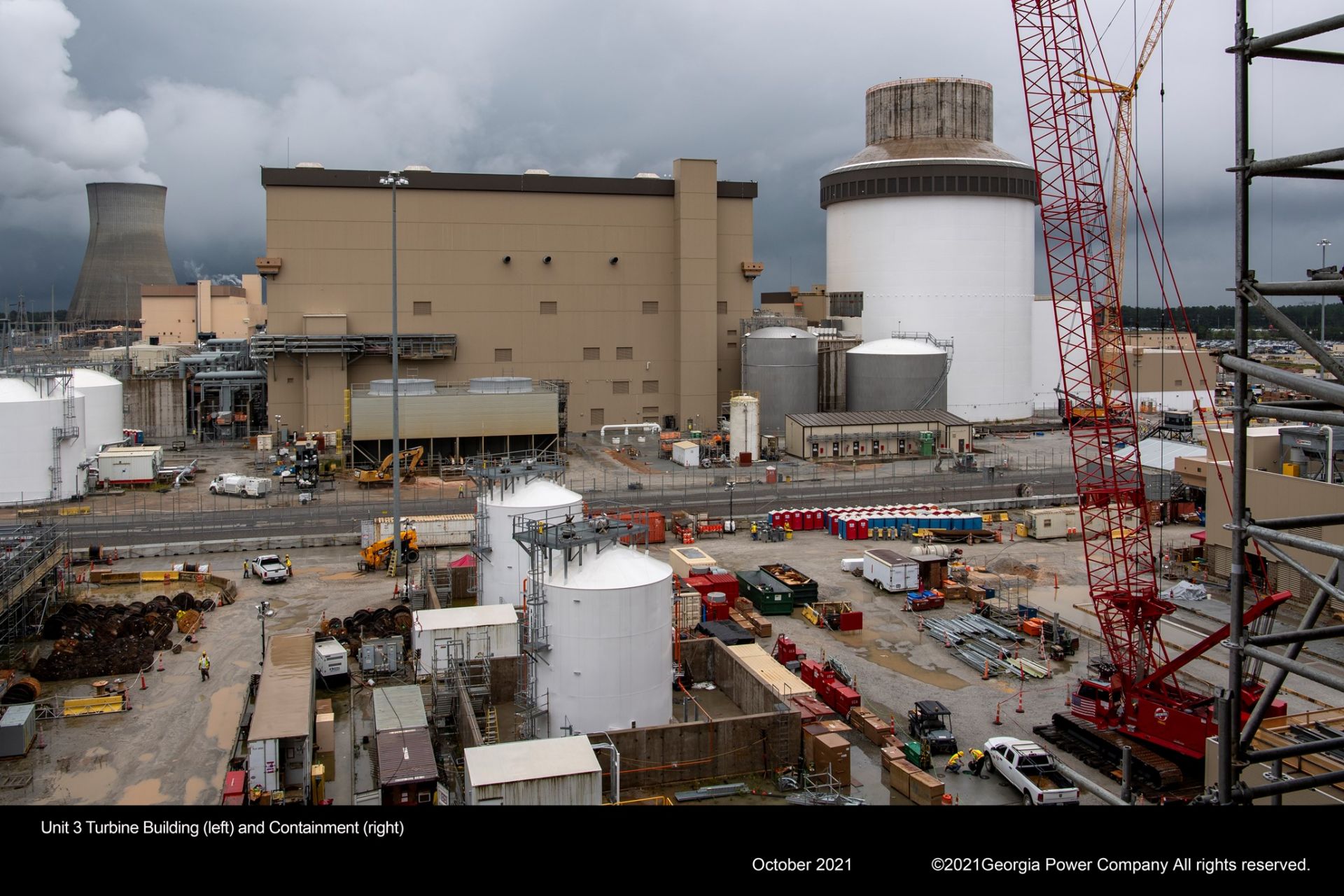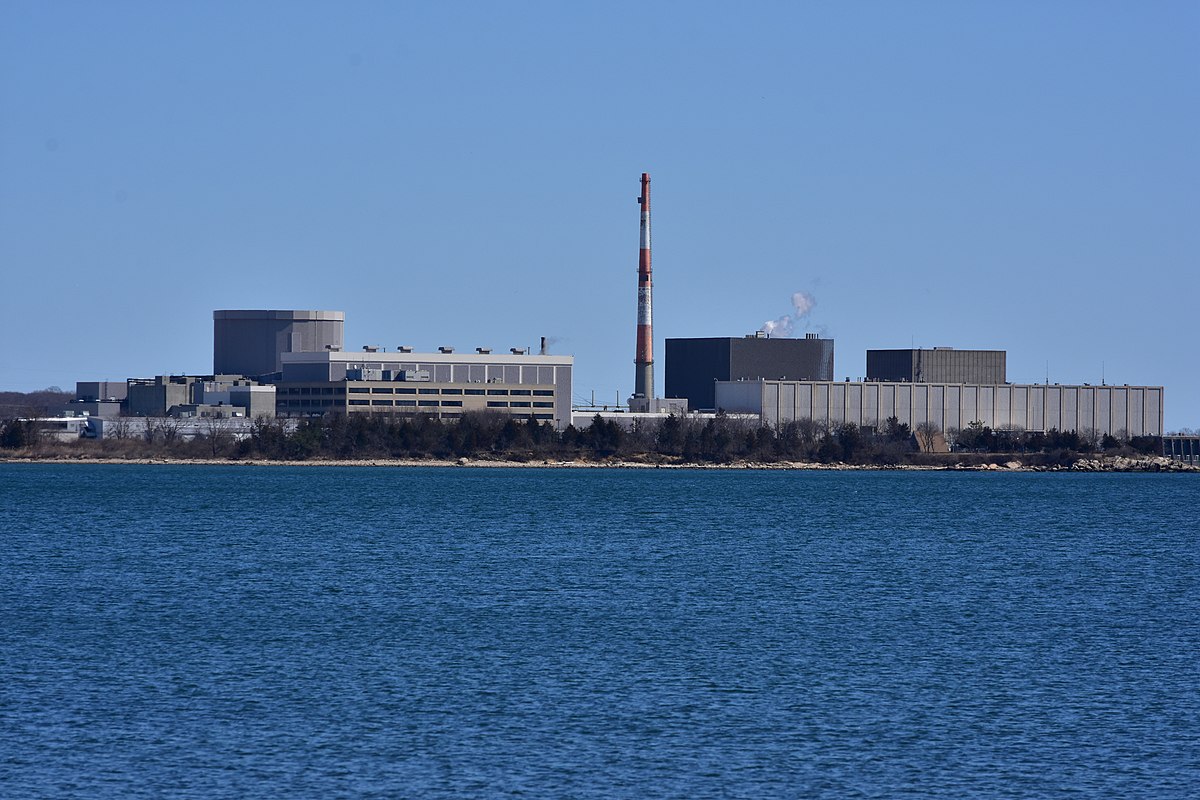The Vogtle-3 turbine building (left) and containment (right) in October. (Photo: Georgia Power)
The Nuclear Regulatory Commission will increase its oversight of Vogtle-3—one of the two Westinghouse AP1000 reactors under construction at the Vogtle nuclear power plant in Waynesboro, Ga.—after finalizing two inspection findings involving the unit’s safety-related electrical cable raceway system. Vogtle’s operator, Southern Nuclear, was informed of the decision in a November 17 letter.
The agency had launched a special inspection at Vogtle-3 in June of this year to determine the cause and extent of construction quality issues in the raceway system, which consists primarily of conduits and cable trays designed to prevent a single event from disabling redundant safety-related equipment.
SwRI engineers used LIDAR point cloud data to reconstruct a high-resolution image of a facility that houses electric turbines at the nuclear power plant. 3D cubes, or voxels, on the left provide spatial information on the turbine facility. Point clouds were reconstructed to create the high-resolution image of the turbines on the right. SwRI specializes in data visualizations to identify damage and potential hazards following accidents at nuclear power plants and other hazardous facilities. (Graphic: SwRI)
During the EnRicH 2021 European Robotics Hackathon, Southwest Research Institute’s unmanned aircraft system (UAS or drone) explored and mapped the interior of a nuclear power plant, detecting radiation sources autonomously, without the aid of a human pilot.
SwRI’s UAS technology can potentially assist in life-saving search-and-rescue missions and hazardous inspections at industrial facilities and infrastructure following natural disasters and other incidents.
Diablo Canyon nuclear plant. (Photo: PG&E)
Last April, Entergy had to close its Indian Point nuclear plant. That’s despite the plant’s being recognized as one of the best-run U.S. nuclear plants. That’s also despite its 20-year license extension process having been nearly completed, with full support from the Nuclear Regulatory Commission.
This closure was due in large part to opposition by antinuclear environmental groups. These groups also mobilized existing negative public opinion on nuclear energy to get politicians to oppose the plant’s license extension. Another factor is unfair market conditions. Nuclear energy doesn’t get due government support—unlike solar, wind, and hydro—despite delivering clean, zero-emissions energy.
November 24, 2021, 2:30PMNuclear Newsthe U.S. Army Corps of Engineers, Baltimore District, Deactivated Nuclear Power Plant Program staff The Sturgis is towed from the Galveston, Texas, pier to the shipping channel on September 25, 2018, as it heads toward Brownsville, Texas, for final shipbreaking and recycling. Over the past three years in Galveston, the U.S. Army Corps of Engineers has been implementing the challenging and complex effort to decommission the MH-1A—the deactivated nuclear reactor that was onboard the Sturgis vessel.
The U.S. Army Corps of Engineers (USACE), Baltimore District, is home to the North Atlantic Division’s Radiological Health Physics Regional (RHPR) Center of Expertise, which is leading the decommissioning of Army reactors.
From 1956 to 1976, the Army’s nuclear power program operated several small nuclear reactors to confirm the feasibility of their meeting military power needs on land. Three Army reactors were deactivated in the 1970s and placed into safe storage awaiting future decommissioning.
Statement from American Nuclear Society President Steven Nesbit and Executive Director/CEO Craig Piercy
A whale swims off the coast by Diablo Canyon nuclear power plant. (Image: PG&E)
The American Nuclear Society supports the continued operation of California's Diablo Canyon nuclear power plant. The premature shutdown of Diablo Canyon units 1 and 2, slated respectively in November 2024 and August 2025, will inflict grave harm to California's economy and environment.
Millstone nuclear power plant
The Nuclear Regulatory Commission has granted Dominion Energy’s request for an increase in the generating capacity of Millstone-3. The Richmond, Va.–based utility had applied for the power uprate last November, requesting an increase of approximately 1.6 percent.
NRC staff determined that Dominion could safely increase the reactor’s heat output, primarily through more accurate means of measuring feedwater flow, according to a November 18 press release. The NRC’s safety evaluation focused on several areas, including the nuclear steam supply systems, instrumentation and control systems, electrical systems, accident evaluations, radiological consequences, fire protection, operations and training, testing, and technical specification changes.
Artist’s concept of a fission surface power system on Mars. (Image: NASA)
NASA and Idaho National Laboratory have just opened a competitive solicitation for U.S. nuclear and space industry leaders to develop innovative technologies for a fission surface power system that could be deployed on the surface of the moon by the end of the decade. Battelle Energy Alliance, the managing and operating contractor for INL, issued a request for proposals and announced the news on November 19. Proposals are due February 17.
Westinghouse president and CEO Patrick Fragman and Energoatom president Petro Kotin sign a contract for the first AP1000 in Ukraine. They are joined by U.S. charge d’affaires to Ukraine Kristina Kvien and Ukraine energy minister Herman Halushchenko. (Photo: Westinghouse)
Westinghouse Electric Company and Energoatom, Ukraine’s state-owned nuclear utility, signed a contract in Kyiv yesterday outlining the details of an agreement to bring the Westinghouse AP1000 reactor to Ukraine’s Khmelnitsky nuclear power plant.
According to a Westinghouse press release, the contract initiates engineering and procurement of long-lead items for the reactor.
Signing the contract were Patrick Fragman, president and chief executive officer of Westinghouse, and Petro Kotin, Energoatom’s acting president. U.S. charge d’affaires to Ukraine, Kristina Kvien, and Ukraine energy minister Herman Halushchenko also attended the event.
The Humboldt Bay nuclear power plant as seen from Humboldt Hill in 2010. (Photo: Wikimedia Commons.)
The license for Pacific Gas & Electric Company’s Humboldt Bay Unit 3 nuclear power plant near Eureka, Calif., has been terminated by the Nuclear Regulatory Commission, and the site has been released for unrestricted use. A 65-MWe boiling water reactor plant, Humboldt Bay-3 operated commercially from 1963 to 1976.
A screenshot from NuScale's latest video about three current research facilities. (Image: NuScale)
The Department of Energy is funding an independent review of NuScale Power’s safety analysis report (SAR), to be conducted by Ukraine’s State Scientific and Technical Center for Nuclear and Radiation Safety (SSTC NRS), the Portland, Ore.–based small modular reactor developer announced on November 18.
Artistic rendering of the Hermes low-power demonstration reactor, a scaled-down demo of the KP-FHR. (Image: Kairos Power)
The Nuclear Regulatory Commission recently issued a draft safety evaluation report indicating initial acceptance of Kairos Power’s source term methodology for its fluoride salt–cooled high-temperature reactor (KP-FHR).
Volunteers staff the Nuclear for Climate booth in the COP26 conference center. (Photo: Raquel Heredia Silva)
ANS sponsored 10 young nuclear professionals from the Young Generation Network, a branch of the U.K.’s Nuclear Institute, to attend COP26, the 2021 United Nations climate change conference, held in Glasgow, Scotland, where they helped deliver what was “by all accounts nuclear’s best representation at the COP ever,” according to George Burnett, one of four U.K.-based attendees sponsored by ANS.
[CLICK IMAGE TO ENLARGE] A comparison between MOOSE results and the analytical solutions for the fractions of point defects in an irradiated spherical Ni grain with a 500 nm radius. The grain boundary/surface at x = 500 nm is assumed perfect and neutral. (Source: From Frontiers in Materials paper "Surface and Size Effects on the Behaviors of Point Defects in Irradiated Crystalline Solids")
By using a combination of physics-based modeling and advanced simulations, Texas A&M University researchers say they have found the key underlying factors that cause radiation damage to nuclear reactors, which could provide insight into designing more radiation-tolerant, high-performance materials.
The Molten Chloride Reactor Experiment will be built at Idaho National Laboratory to demonstrate criticality in a fast-spectrum salt-cooled reactor within five years. (Image: Southern Company)
 and containment (right).jpg)



















